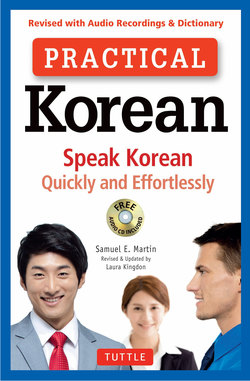Читать книгу Practical Korean - Samuel E. Martin - Страница 16
ОглавлениеLESSON 9
Styles of Speech
Each Korean sentence can be said in many different ways, depending on who is talking to whom. In America, even if you divide the people up into regular folks and snobs, you still talk much the same way to anyone. But a Korean uses different verb forms at the end of his or her sentence for different people he or she talks to. The system is quite complicated, and as a foreigner you won’t be expected to get the hang of it right away.
There are actually seven different levels of politeness in Korean, but only five are used in modern speech, and only three of those are common. This book will only teach the five used in modern Korean speech.
(The other two are now taught only in advanced Korean classes and the student will never, ever need to know them, much less from a book for beginners.)
In this book most of the sentences are in the POLITE or yo style, because this is the simplest to learn, and it is also the most generally useful. Some of the sentences, especially set greetings, are given in the FORMAL or -seumnida style.
Since you will hear a lot of the other styles, too, you had better know a little about them. In some of the styles there are different endings depending on whether your sentence is a STATEMENT, QUESTION, COMMAND or PROPOSITION. In others, particularly the polite style, people will often use the same ending for all these types of sentences, and the only ways to tell them apart are intonation and context.
There are many different verb endings that can be used with the polite style, but most are beyond the scope of this book.
In making a command or proposition, Koreans often use the formal style even though they would ordinarily be talking to the person in the polite style—it’s like adding “please” in English. On the next page is a list of some of the endings characteristic of the various styles.
The use of these styles is somewhat like this. You use the formal style to persons of higher status than you, though most people switch to the polite style once they know each other a little bit. However, while you can eventually switch to the intimate style with people your age or younger once you’re friends, you never switch to the intimate style with someone in a position of authority over you, no matter how long you’ve known them and also to other people in formal situations. To strangers, you use the formal style until the ice is broken—after that, the polite style.
You use the intimate style (which is just the polite style with the polite particle yo dropped) with close friends and relatives who are younger or whom you know very well. Some people use this style with their parents (though some always keep using the polite style), but you would never, ever use it toward your grandparents.
You use the plain style in talking to children, and sometimes with close friends and relatives. You use the quotation style (which is almost identical with the plain) when you are quoting what someone has said; or when writing an article or book.
The familiar style is now somewhat archaic and only really used by older people. Don’t worry too much about learning it. Most people nowadays use the intimate style with close friends, children, and relatives who are either very close or younger.
Speech styles are quite different from “honorifics,” discussed in Lesson 25.
See if you can identify the style of each of the following utterances just by their endings. Don’t memorize the sentences:
Bi-ga wasseumnikka?
비가 왔습니까?
Did it rain?
Yeogi-seo Jungguk eumsik-eul meogeulsu isseoyo?
여기서 중국음식을 먹을 수 있어요?
Can I eat (= be served) Chinese food here?
Naeil olgeyo.
내일 올게요.
I’ll come back tomorrow.
Bang-i eopseoyo?
방이 없어요?
Haven’t you a (vacant) room?
Eonje onayo?
언제 오나요?
When did you get here?
Jamkkan shwipsida.
잠깐 쉽시다.
Let’s rest a minute.
Yeogi anjara.
여기 앉아라.
Sit here.
Igeot boseyo.
이것 보세요.
Look at this.
Ppalli gaseyo.
빨리 가세요
Please go fast.
Jip-e oseyo.
집에 오세요.
Come to (my) house.
Mwo hani?
뭐 하니?
What are you doing?
Gachi haja.
같이 하자.
Let’s do it together.
Jigeum moegeosseoyo.
지금 먹었어요.
I’ve just now eaten.
Geu chaek-eul beolsseo ilgeosseoyo?
그 책을 벌써 읽었어요?
Have you already seen (or read) that book?
Iri wa.
이리와.
Come this way.
Pyeonghwa-ga olkkayo?
평화가 올까요?
Will peace come?
Geu-neun gongbu-reul yeolsim(h)i handa.
그는 공부를 열심히 한다.
He studies hard.
Geu goyangi-neun yeppeuda.
그 고양이는 예쁘다.
The cat is pretty.
Neomu jakda.
너무 작다.
It’s too small.
Keumnikka?
큽니까?
Is it large?
Yeoboseyo.
여보세요.
Hello. (when answering a phone call)
Yeogiyo.
여기요.
Look, excuse me... (Literally means, here)
